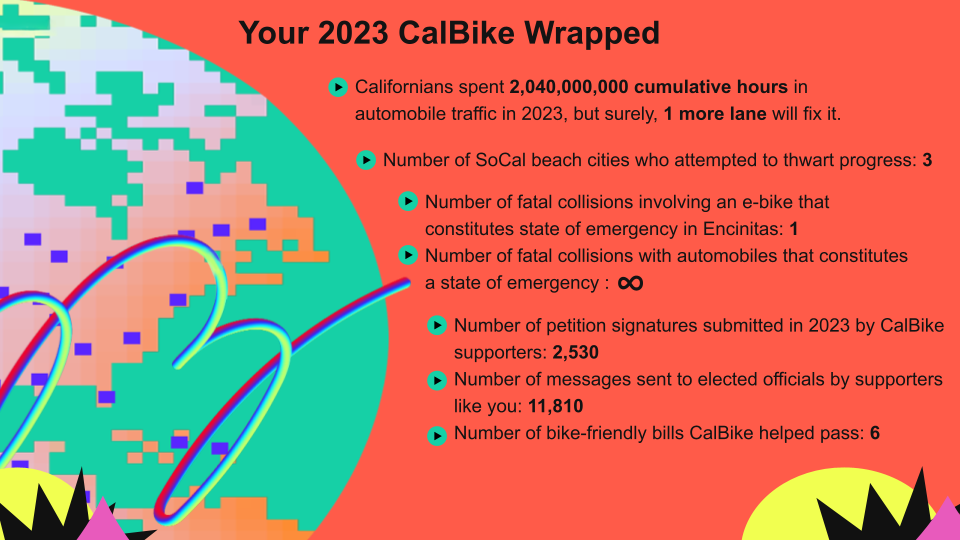CalBike’s Best and Worst of 2023
After 2020, it seemed like things could only get better, or at least more normal. But weird seems to be the new normal, and 2023 was no exception, with a high-profile firing at Caltrans, cities declaring “e-bike emergencies,” and fast transportation mode shifts caused by freeway shutdowns rather than the ongoing emergency of climate change.
There have also been significant positive moves this year: legislation that will make streets significantly safer for people biking and walking, funding wins for active transportation, and an expanding coalition of groups amping up the pressure for California to turn to green transportation.
This year, we’re mixing things up by adding some (tongue-in-cheek) awards and our first CalBike Wrapped! We hope this holiday season is a time of renewal for you, and you come back in the new year ready to make it the best year ever for biking in California!
Worst attempt to hush up an unsanctioned freeway expansion that drew more attention to the problem and could lead to a whole agency restructuring: Caltrans firing Jeanie Ward-Waller

Caltrans fired Deputy Director for Planning & Modal Programs Jeanie Ward-Waller because she planned to blow the whistle on potentially illegal use of state highway repair funds to build an extra lane on I-80’s Yolo Causeway. The firing of CalBike’s former Policy Director, and one of the strongest voices in support of active transportation at Caltrans, set off a firestorm, leading to calls for greater oversight of the agency. It has also drawn greater scrutiny to freeway expansion projects like the Yolo Causeway expansion that Caltrans was trying to keep under the radar. Well done, Caltrans.
Best response to alleged state agency malfeasance: Community pushback on Caltrans after Ward-Waller firing
Change has been slow to come to Caltrans, which still mostly prioritizes moving cars and trucks over keeping people biking and walking safe and continues to approve projects that violate California’s climate policies. However, we’re encouraged by growing momentum in the movement to change Caltrans after the agency kicked out its most visible advocate for climate-friendly transportation infrastructure. CalBike was one of over 100 signatories on a letter to the governor asking for investigations of Caltrans operations and a halt to freeway expansion projects in the meantime. And there will be more action to come in 2024, with coalitions coalescing around forcing California to live up to its green transportation policies.
The Worst Euphemism Award: “Pavement rehab” by Caltrans
Why is it that highway resurfacing projects like the Yolo Causeway “pavement rehab” end up adding lanes — and VMT — to the roadbed? Hmm….
Sleeper bill that could have the biggest impact in the future: SB 695, Caltrans data transparency

Oversight is the key to changing how Caltrans operates. In the past, data about freeway projects was not only hard to parse but also hard to find. The Caltrans Data Transparency Bill, AB 695, authored by Senator Lena Gonzalez, requires the agency to make data about past and planned projects available on its website starting in 2025. It’s an excellent step toward a more accountable Caltrans.
The Don’t Threaten Us With a Good Time Award: 10 Freeway 6-Day Closure “Crisis”

The City of Los Angeles declared a state of emergency when a fire under an overpass shut down a portion of the I-10 freeway. It was such an emergency that city officials called on residents to do something radical: leave their cars at home and take the Metro. The transit agency even changed signal priority to make trains run faster. While that’s all great — and was all too temporary — it’s ironic a freeway closure led to these changes and not, for example, the ongoing and not easily reversible climate emergency made worse by LA traffic every day. Just saying.
Best budget decisions, state legislature edition: Reinstatement of full funding for ATP in final budget

In 2022, a year of budget surpluses, California put some of its excess funds, $1.05 billion, toward the Active Transportation Program, which funds biking and walking infrastructure projects across the state. As it became clear the State had to cut corners in 2023, the governor’s first draft budget cut half of that additional ATP funding, about $500 million. Happily, thanks to pressure from CalBike supporters who sent hundreds of letters to the budget committees and to our champions in the legislature, that funding was fully restored in the final budget. Of course, it’s still not nearly enough, and many excellent projects weren’t funded in the most recent funding round of the ATP (Cycle 6). We’ll continue to fight for more funding for active transportation in 2024.
Best budget decisions, state agency edition: CARB including $18 million for e-bike incentives as part of its clean transportation allocation
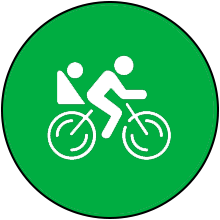
Although the rollout of the statewide E-Bike Incentive Project has been slower than anticipated, the California Air Resources Board (CARB) clearly recognizes that it will be a popular program. In addition to finding an extra $3 million on top of the $10 million allocated for the pilot by the legislature, CARB proposes $18 million for the program in the next fiscal year. That’s still a small amount compared to the size of California and the high demand for incentives, but it’s a significant chunk of CARB’s clean transportation budget and an excellent start as the program ramps up.
Worst response to a driver hitting and killing a bicyclist: Encinitas e-bike emergency after the death of Brodee Champlain-Kingman

What do you do if a person driving a car hits and kills a person riding a bike? What if the person riding the bike followed the rules of the road and “did everything right?” If you’re the City of Encinitas, you declare a state of emergency because — e-bike! Surely it must be the increased number of e-bikes on the road that’s causing drivers to hit them and not the fact that we haven’t built enough safe bikeways and our roads are designed to encourage people to drive fast. It’s the worst kind of victim-blaming that does nothing to address the actual problem.
Worst media take: New York Times elevates e-bike backlash

The New York Times jumped into the anti-e-bike fray with both feet…in its mouth. A series of articles about the dangers of e-bikes (cue scary music) in California, including a front-page article that blamed reckless teenage riders for recent collisions, using a bike rider killed after being rear-ended by motor vehicle driver, while the bike rider was obeying the rules of the road, as an example. With a fight over e-bike licensing looming in New York City, the paper has an opportunity to take a more balanced approach, but will it? Do better, NYT!
Best media response to worst media take: Streetsblog article on how to spot bad bike reporting
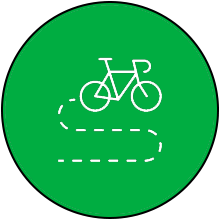
The bikelash posts spurred a backlash against the Times’s biased reporting, including CalBike’s guide to reporting on collisions involving e-bikes (and bikes in general). But we take our hats off to Streetsblog USA for the best response: Four Ways To Spot a Bad E-Bike Article by Kea Wilson. Favorite quote: “A Bad E-Bike Article doesn’t just make e-bikes look bad; it erases all the harm that the mode can reduce by replacing car trips, particularly when supported by great infrastructure, policy, and education to match. Until papers of record start telling that story, though, we should probably all remain prepared to call out Bad E-Bike Articles when we see them.”
The Footloose Award: Huntington Beach City Council

This award, named in honor of the movie, is given to the local elected body most committed to the misery of teenagers. Several Southern California cities recently decided that e-bikes are a menace, but Huntington Beach, whose city council likes to dabble in performative provocation, focused its ire on the dreaded youth on an e-bike (cue very scary music). This fall, the City enacted draconian e-bike regulations that single out people under 18. When a juvenile — but not an adult — is found to have violated the ordinance, Huntington Beach can impound their bike. What’s next, HB? A new law taking candy from babies?
Best legislation that will save pedestrian lives: The Daylighting to Save Lives Bill, AB 413

The Daylighting to Save Lives Bill, AB 413, authored by Assemblymember Alex Lee, makes it illegal to park within 20 feet of a marked or unmarked crosswalk. It’s one simple change that will improve visibility at intersections, reduce collisions, and make pedestrians and bicyclists safer.
About Time Award for a proven strategy to slow traffic on dangerous streets: AB 645, speed camera pilot finally becomes law
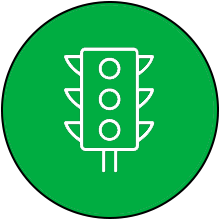
Finally! After dying in the legislature more than once, Assemblymember Laura Friedman’s automated speed enforcement pilot, AB 645, is moving forward. Starting in 2024, six California cities can use cameras to capture and ticket speeding cars. We look forward to seeing the results of the pilot and hope this is the first step in allowing speed cameras statewide.
Biggest loss for active transportation in the Assembly that could become a win at the federal level: Laura Friedman running for U.S. Congress
Assemblymember Laura Friedman has been a strong supporter of active transportation and an important ally in her role as chair of the Assembly Transportation Committee. Her run for Congress in California’s 30th District is bittersweet. While we’re sure she will do great things in D.C., we’ll miss her voice in California politics.
Best idea we’re not sure will work: Bike czar at Caltrans
Senator Anthony Portantino found bicycling during the pandemic and has become a powerful ally. We like his bold policy positions, including his bill to create the position of Bike Czar at Caltrans, SB 538. We’re just not sure we believe it will work. If Caltrans is willing to give the position power and listen to recommendations from that office, it could be part of a much-needed reorientation. But, given the ouster of Jeanie Ward-Waller and general agency intransigence, we’re going to hold our applause for now.
Worst response to the climate emergency: Every. Single. Thing. We. Do.
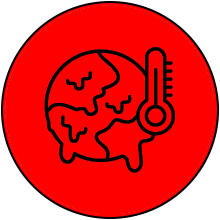
Despite an ongoing string of hard-to-ignore climate disasters and another one of the hottest years on record, California (and the whole U.S.) continues to drive with unwavering determination toward the climate cliff. Oh, and there was that climate summit in Dubai, a famously energy-intensive desert city that makes all its money from oil. Go us!
Still, there’s no reason to be concerned. California will build more 15-minute neighborhoods and bikeable, walkable streets. Just give us a decade or two to fight over the plans and figure out if we can give up a few parking spaces. No problem. Mother Nature is famously patient and willing to work within our time frames.
Best event to look forward to in 2024: the California Bicycle Summit in San Diego
The California Bicycle Summit is back and better than ever! The 2024 Summit will be held in lovely San Diego on April 18-19, and we can’t wait to get together and share ideas with all of you to make 2024 a year of many bests. Register now.
